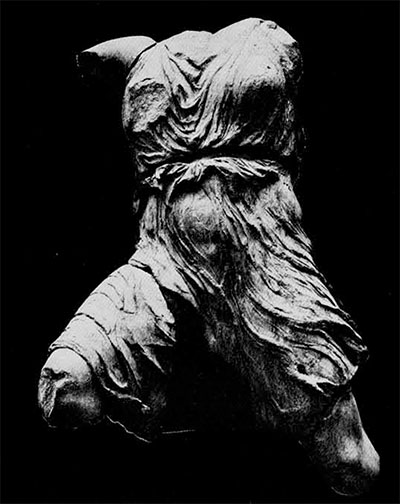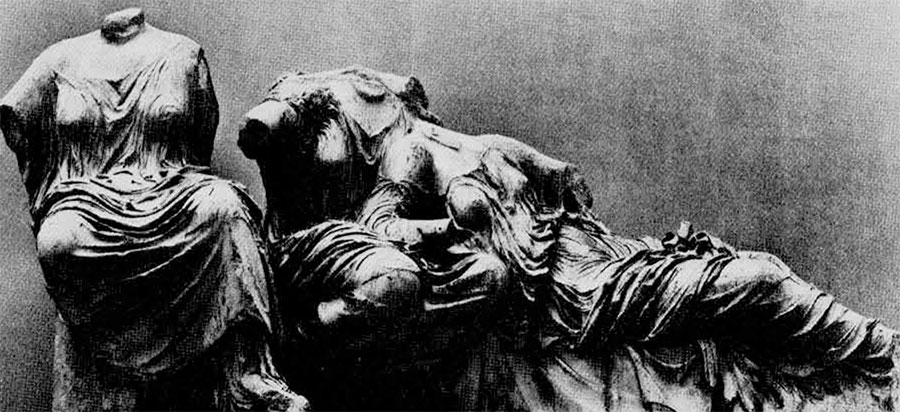

A remarkable piece of archaeological detective work—in effect the solving of a three-dimensional jigsaw puzzle—has “recovered” one of the few Greek cult statues extant, and of these it is one of the earliest. It is the heroic-size marble figure of Nemesis sculpted by Pheidias’ favorite pupil, Agorakritos of Paros, at her shrine at Rhamnous, near Marathon.
The achievement, recently completed, is the result of three years of laborious investigation by George Despinis, Professor of Archaeology at Thessalonika University. He collected and assembled (on paper, at least) some 340 fragments of the famous figure to supplement the only piece of it hitherto known, a badly damaged part of the head in the British Museum. Further digging at Rhamnous should produce more; as of now, about one-fifth of the statue, by volume, has been recovered.
Despinis’ work, however, has far greater significance than the mere assemblage of chunks from a much admired masterpiece that until now had been assumed to be totally irretrievable. More importantly, from a study of the fragments Despinis has been able for the first time to determine with precision the style and unique genius of Agorakritos and from that knowledge to identify those portions of the Parthenon pediments and friezes done by him under Pheidias’ direction. Another result has been the determination of which of the eleven known Roman copies of the Nemesis is the most nearly accurate. It happens to be the one in the Copenhagen Ny Carlsberg Glyptothek, about half the size of the original.
The work of Agorakritos was widely known and inordinately admired in antiquity. Besides the Nemesis, he is known to have made a colossal marble statue of the Mother of the Gods for the Metroon in the Athenian Agora and bronze statues of Athena Itonia with Zeus-Hades in Koroneia. Several reproductions of the first have been identified and recently one of the Zeus-Hades head. But it was the Nemesis that was acknowledged as Agorakritos’ greatest work. The praetor Marcus Terentius Varro, a hugely fecund writer and scholar, considered it, according to Pliny, “superior to every other statue.” Strabo called it “a work which both in grandeur and beauty is a great success and rivals the work of Pheidias.” Pausanias, who like Pliny reports the tradition that Agorakritos was Pheidias’ lover as well as pupil, recounts the most famous of the legends about the statue:

(Lower) Part of the inner side of the right arm of the statue of Nemesis in the National Museum, Athens.
“About eight miles north of Marathon,” he wrote in the second century A.D. in his famous Description of Greece, is a sanctuary of Nemesis, the most implacable deity to men of violence. It is thought that the wrath of the goddess fell also upon the foreigners [i.e. the Persians’ who landed at Marathon. For thinking in their pride that nothing stood in the way of their taking Athens, they were bringing a piece of Parian marble to make a trophy, convinced that their task was already finished. Of this marble Pheidias made a statue of Nemesis, and on the head of the goddess is a crown with deer and small images of victory. In her left hand she holds an apple branch [her characteristic symbol], in her right hand a cup….” He goes on to describe in considerable detail the pedestal of the statue, heavily populated with the figures of Helen being led to Nemesis by Leda, of Tyndareus (Leda’s husband), Agamemnon, Menelaus and others. (There were two main traditions on the motherhood of Helen. In one she was the daughter of Leda by Zeus; in the other, she was the daughter of Nemesis but suckled and nursed by Leda.)
If Pausanius believed that it was Pheidias rather than Agorakritos who sculpted the cult statue, tradition and other sources hold a contrary view and Despinis himself has no doubts, finding it stylistically developed beyond the work of Pericles’ great supervisor, “a new departure which begins a new style and ways that go further than the vision of Pheidias.” Pliny notes that Agorakritos was “a great favorite of his master, on account of his extremely youthful age,” and for that reason Pheidias gave his own name to many of his young pupil’s works. But in any event, according to Zenobius, Agorakritos signed the statue of Nemesis and put near his name his epithet, Parios (“from Paros”).
Pliny’s story of the statue is that Agorakritos and another pupil of Pheidias, an Athenian named Alkamenes, entered into a competition to make a statue of Venus. Alkamenes’ creation was voted the winner by the Athenians, “not that his work was superior but because his fellow citizens chose to give their suffrages in his favor in preference to a stranger” from Paros. Furious at an early example of home-town favoritism, Pliny continues, Agorakritos sold his’statue on the express condition that it should never be taken to Athens, and changed its name to Nemesis. The truth of the story is debatable.
Pausanius’ account is the more engaging. It is pleasant to think that the man from Paros, who knew the beautiful marble of his island from childhood, was delighted to find a block of it, arrogantly imported to Marathon by the Persians, and to carve it into the personification of justice and retribution. And we can take Despinis’ evidence for it that Agorakritos was indeed the sculptor. The statue can be confidently dated to about 430 B.C. and was probably placed in the sanctuary four or five years later, when the pedestal was also made. It was destroyed (energetically and systematically, the number of small fragments make clear) in the fourth century A.D., presumably by the fanatical Christians whom Theodosius allowed free rein to smash pagan temples and statues.
In 1812/13, with the major Roman and lesser Byzantine references to the statue no doubt carefully digested, that remarkable group of early British Classophiles, the Society of the Dilettanti, made the first excavation of the sanctuary of Rhamnous and triumphantly bore back to London the head of the goddess. It stands now in the British Museum’s storerooms like a huge cannonball, a large part of the back of the head sliced off and gone, and the whole left side scraped to unrecognizability; only the right eye and part of the coiffure on that side give evidence of beautiful work.

In the late 1960’s, Despinis and the sculpture expert of the National Museum in Athens, S. T. Triantis, spotted a few fragments of interest at Rhamnous and set about searching for more in the storerooms of the Athens museum and in the storehouse at Rhamnous itself. One thing, quite literally, led to another: old records were rediscovered, one fragment suggested another. Despinis was able to connect them, hypothetically at first, with the cult statue and the head in London, on the evidence of the new-found records, the Parian marble, the scale, the dating and “especially the exceptional quality of workmanship.” The first 70 fragments collected permitted “a secure definition” of the basic characteristics of the type. It is noteworthy that in a field as disputatious and contumacious as Classical identification, Despinis’ judgments are challenged by none but acknowledged without question by those students who have examined the matter.
Although other portions of cult statues, originally lodged in temple cellas, have been found, they generally date from the fourth century, Hellenistic times or later; the Nemesis is one of the precious few examples from the dull Classical period of the fifth century.
The key fragments for the identification not merely of the statue itself but for the sculptor’s characteristic style and extraordinary artistry were, among others, one from the back of the neck showing the coiffure; the lower part of the right leg; pieces of the right arm; the right thigh; part of the plinth and drapery between the feet, and part of the back and left side. Together, and with the British Museum head, they permitted Despinis to calculate the exact size of the statue, 3.55 m. high, and to establish beyond dispute the dress, a chiton or tunic, which was girdled, and a himation or cloak, both with voluminous folds, sweepingly graceful lines and—what Despinis finds a striking step beyond the style of Pheidias —a departure from the simple and austere style in dress to one rich in detail and free of the body, a “transparency” under which the lines of the body emerge.

Working reciprocally from fragments to copies and copies to fragments—and from the combination to determine style and workmanship —Despinis has now made bold to make further identifications of Agorakritos’ other works. Again, the identifications have not so far been challenged by other Classical scholars. He declares that the richness and variety of the dresses of the group of Aphrodite in the East Pediment of the Parthenon, the group of Iris in the West Pediment and the group of Hermes, Dionysos, Demeter and Ares in the East Frieze proclaim them as the work of Agorakritos and his atelier.
The years of the East Frieze,” Despinis has said, “see the decisive period in the evolution of the artist. The relief of the gods marks the end of his apprenticeship to Pheidias. The young artist with personal and mature style here produces one of his first large masterpieces. His temperament and potential in the working of the marble, an inheritance over a long tradition of his island, took wing from the love of Pheidias and made him distinguish himself from the other artists who carved the rest of the relief in the East Frieze. His experiences in marble and his restless nature must have surely made the supreme artist of the Parthenon fall in love with the young sculptor. It is not at all improbable that the tradition which makes him a lover of Pheidias is true. How much Pheidias loved Agorakritos will always remain unknown, but how much Agorakritos loved and admired his teacher he has shown, with undeniable evidence, in his work.”
Despinis feels that the period of Agorakritos’ maturity starts with the Parthenon friezes and climaxes in the statue of Nemesis where “his inspiration is still Pheidian but his personal style has affirmed itself.”

One leaves Despinis’ detective work with an afterthought that will not be put down. Is the time not now ripe to accompany the excavation that goes on at tempting sites in the field with a bit of new exploration of the reserves, storerooms and storehouses at some of the famous sites long since dug up and at some of the huge museums in their countries? What else of great importance may there be, set aside by early archaeologists as fragments too small to be dealt with but too close to their one-time shovels to be thrown away, gathering dust in the cellars of Athens, Rome, Naples, Cairo and Istanbul?
